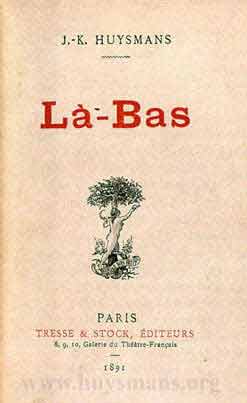The National Observer
June 20, 1891.
NATURALISM V. DECADENCE
L’Argent. Par ÉMILE ZOLA. Paris: Charpentier.
Là-bas. Par J.-K. HUYSMANS. Paris: Tresse et Stock.
There is disunion in the fold. Naturalists and Decadents have come to loggerheads; and while M. Huysmans reproaches Zola with L’immondice de ses idées, and hurls it in his teeth that he has not only embodied materialism in literature but glorified the democracy of art, the author of l’Argent retaliates with scorn that Huysmans and his friends are but nutshells dancing on the crest of Niagara. The quarrel is a pretty one, and its remarkable feature is that either party dared to bring a charge of immondice against the other. The hostile points of view are well enough illustrated in the last manifestoes of both; and those who are interested in the comparative study of filth will find in là-Bas as in l’Argent an abundance of excellent material.
M. Huysmans, who is nothing if not a keen and searching critic, has at last discovered his ideal. The true Naturalism is the Naturalism of the Primitives. You may be as brutal as as you like, if only you throw a cloak of occultism and mystery over your materialism. In the museum of Cassel there is a Crucifixion by Mathaeus Grünwald, wherein the abject misery of the Man of Sorrows is presented without restraint or palliation. The picture is mystic, and is concerned only with the ideals of the past, but to M. Huysmans it is a true symbol of art. Let your material, he says in effect, be as savage as you will; but if you disengage it from modern life, if you scorn the paltry realism of the tall hat and frock-coat, if you ignore the voter and turn you aside from the democracy, your art shall be pure of brutality, and though poisonous it will appear beautiful. Là-Bas is a practical application of the theory. The story of Gilles de Rais, conceived in a modern guise, might be as immonde as Zola himself, but it belongs to the far-distant past, it is wrapt in the impenetrable mystery of Satanism, and is therefore fascinating to the artist and the decadent. M. Huysmans is a writer of conspicuous and personal talent, and we are amazed that he has given us so pallid a picture of the monumental precursor of the Marquis de Sade. But in truth this is but an under-current of Là-Bas, and the curious will skip such chapters as deal with Blue Beard and find their amusement in the occultism of to-day. The intrigue between M. Durtal and Madame Chantelouve, which culminates in a terrible celebration of the messe noire, would seem naturalistic were it not deeply embroiled with diabolism and black magic, which arts M. Huysmans tells us are daily practised not only in Paris but in modern Scotland! The literary criticisms which are introduced by the way are often admirable. Could the works of the psychologues be better described than as ’pastilles mi-sucre, mi-sel, la littérature de Vichy’? But the best of the book is the picture of the secluded life lived by the bell-ringer of St. Sulpice and his friends in the heart of Paris yet separated by centuries from the intrigues of Boulanger and the follies of politicians. But in spite of its brilliance and erudition, là-Bas is not a complete success. You come to pray, and you remain to laugh. Its author is too self-consciously decadent to convince. The crimes of Gilles de Rais were suggested to him by a study of The Twelve Caesars: Suetonius was a decadent, therefore the proper material for M. Huysmans’ art is Gilles de Rais. This is so intelligent that it can hardly be sincere. The true decadadent — Suetonius and Lucan, for example — did not advertise themselves as decadents. They took up a literary convention which had done its best work, and to satisfy their longings for personal expression they introduced fresh ideas and a new method. M. Huysmans, in his burning anxiety to be decadent, is content to mimic the decay of the classical school. So that, like the Pre-Raphaelites, he has retrieved an old tradition, and is a decadent rather by pose than in reality.
M. Zola, on the other hand, represents the true decay of Romanticism. By temperament a moralist, he has adhered faithfully to the romantic method; but to separate himself from his predecessors he brought to perfection the literary pétard. L’Argent is a serious and congested study of the Bourse. It may be described as a tract against gambling (with digressions). The figure of M. Saccard, whose passionate lust for money is almost lyrical, is elevated far above everyday realism. As becomes a hero of romance, he comports himself with an exaltation of courage in his hour of stress. His two sons, Victor, savage and illegitimate, Maxime, blackguard and raffiné — are symbols of the influence of money, which, says Zola in an outburst of moral indignation, is ’l’éducation, la santé, l’intelligence.’ For Zola, indeed, is not only your true decadent, he is also your true symboliste. But l’Argent, the two bombs notwithstanding — and one of them, rape by a boy of fifteen is new even to les Rougon-Macquart — is tedious reading. Madame Caroline the ever-young, the grey-haired, the benevolent, is admirably done, and there are powerful passages not a few; but the intention is too obvious, the purpose too serious and in spite of his follies we prefer M. Huysmans. Put-up as là-Bas is, it is at least entertaining; and as we failed to detect a plot, so the purpose evaded our most vigilant research.

